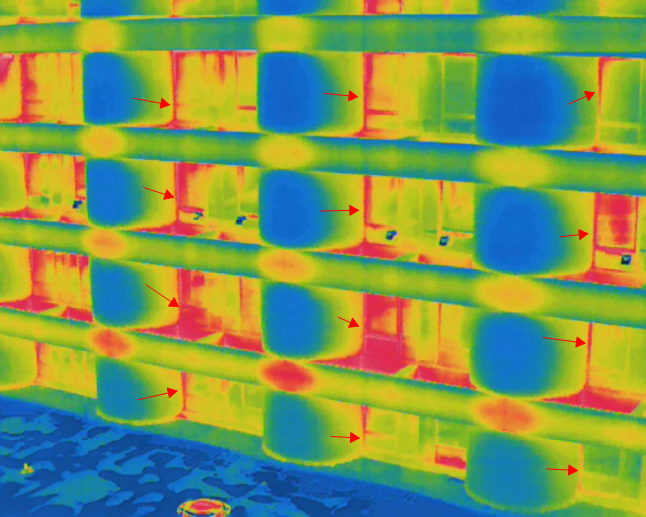
5 key benefits of advanced inspection systems on the jobsite
By John Yunker
In a recent report from Autodesk + FMI, 71% of building owners said capturing and retaining data during design and construction helps reduce lifecycle operations costs. While this data can be obtained using several methods, at Skanska we’ve found that using AI, machine learning and advanced technology to collect data can reduce costs on utility usage, repairs and future replacements.
At Skanska, we have begun using drones – unmanned aerial vehicles – to inspect existing buildings, allowing us to collect data more efficiently, especially on key structural targets. More recently, we have been testing the boundaries of this technology’s capabilities by using thermal drones to identify weak points in structural insulation.
What is a thermal drone?
A thermal drone is a standard drone equipped with temperature-sensitive cameras that can identify and record infrared radiation signatures in hard-to-reach locations. It works by detecting infrared radiation (heat) that is emitted by objects. This data is then processed to produce a thermal image on a screen, showing temperature variations in the area being surveyed. In construction, these drones are often used to locate failing insulation, which can result in heat leaks and cold spots in a structure. These drones accurately relay data and identify potential building upgrades, whether a project is newly built or long-standing.
Why does it matter?
As superintendents, we can proactively implement digital technologies, like thermal drones, to make incremental improvements to habitual processes that can offset these overarching costs, keep construction data up to date, and increase project ROI.
Drones in action
In close collaboration with our Emerging Tech team, a comprehensive structural inspection was conducted by the project team at Mercy Health’s Lourdes Hospital located in Paducah, Kentucky. For this healthcare renovation/addition project, the team wanted to demonstrate to the owner and owner representative how minor upgrades to the existing building could result in significant long-term cost savings by boosting energy efficiency and mitigating the risk of moisture/water damage.
Leveraging the advanced capabilities of thermal imaging drones, the team uncovered numerous areas requiring remediation. These included walls with deteriorated caulking and inadequate insulation, as well as a roof membrane that exhibited air gaps and hot spots – potential precursors that can lead to moisture accumulation and leaks. The lack of insulation was leading to substantial thermal loss, notably from the roofing seams, which could result in elevated energy expenses for the client.
With this information at hand, the hospital took decisive action to reinsulate both the walls and roofing of the building. This intervention led to a dramatic decrease in overall energy costs.
Traditional inspections necessitate two skilled craftsmen and extensive planning for up to two months. Conversely, drone inspections require just a single licensed operator, who can conduct assessments and produce reports within the same day. All factors considered, this entire process took roughly a week with drones as opposed to two months without this technology. This represents a significant efficiency improvement and demonstrates the importance of harnessing innovative technology for optimal results.
5 takeaways
- Efficiency. Drones allow data to be collected and uploaded at a rate unmatched by traditional methods. Typically, a drone-based inspection requires just one licensed operator, who can perform the inspections and quickly generate reports. This information can also be uploaded and shared instantaneously with all project stakeholders.
- Safety. Safety is the top priority for superintendents. Traditional inspection methods often involve numerous in-person assessments, potentially exposing workers to hazards such as confined spaces, unstable roofs or scaffolding and areas with compromised air quality. Drones serve as a tool to mitigate these risks. Their ability to access hazardous or hard-to-reach areas without human intervention significantly minimizes the likelihood of workplace accidents and injuries, thereby enhancing overall site safety and efficiency.
- Data accuracy. Drones can be flown between structures and access hard-to-reach areas that may otherwise be inaccessible. Providing precise and consistent measurements, they collect invaluable data that offers insights for enhancing daily operations and staying ahead of structural modifications. Their capacity to conduct repeatable surveys over time is instrumental in tracking progress and identifying patterns – all vital elements for maintaining efficiency and quality in projects.
- Sustainability. By identifying areas of heat loss in buildings, thermal drones can help optimize energy usage. This can lead to significant savings on heating and cooling costs and reduce the overall carbon footprint of a building. By identifying structural issues early, these devices can also help prevent unnecessary building repairs or replacements, saving materials and reducing waste.
- Quality assurance. Thermal imaging can detect issues not visible to the naked eye, such as water leaks, insulation gaps, electrical faults or structural defects. Early detection of these issues allows for timely repairs and prevents further damage, and helps owners optimize energy consumption and reduce costs.
Technological advances are streamlining construction efficiency while supporting sustainability efforts, cutting costs for long-term projects and improving site conditions for standing structures and new construction projects. Proactive use of these technologies can help the superintendent get a proactive full picture and speed up the timeline of site work.
John Yunker is a general superintendent for Skanska USA Building in Nashville, Tennessee.
Sources:
https://injuryfacts.nsc.org/work/work-overview/work-safety-introduction/
https://www.autodesk.com/blogs/construction/construction-industry-statistics/#Usage
https://www.consultengsurvivor.com/the-cost-of-building-maintenance


 Join our thriving community of 70,000+ superintendents and trade professionals on LinkedIn!
Join our thriving community of 70,000+ superintendents and trade professionals on LinkedIn! Search our job board for your next opportunity, or post an opening within your company.
Search our job board for your next opportunity, or post an opening within your company. Subscribe to our monthly
Construction Superintendent eNewsletter and stay current.
Subscribe to our monthly
Construction Superintendent eNewsletter and stay current.